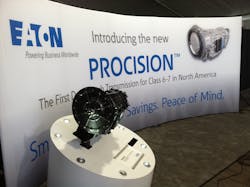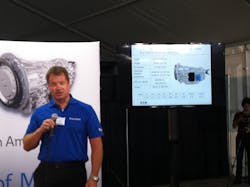Marshall, MI. Eaton Corp. is expected to bring to market a new 7-speed, medium-duty dual clutch transmission by the middle of next year. According to Eaton, the Procision delivers 8-10% better fuel economy in a similarly equipped vehicle using a torque converter automatic transmission.
Thanks to its electronic shifting, the transmission is able to optimize fuel efficiency by using grade, vehicle weight and throttle input to provide smooth, continuous delivery of torque.
One of the keys to the transmission is its dual clutch technology, which makes gear changes by “swapping the engine torque between clutches with the next gear preselected.”
“The upshot with a dual clutch design is that the slower you go, the more starts and stops you do, and more grades you negotiate at slow speeds, the better your fuel economy will be,” said Jeff Carpenter, engineering manager for Procision.
Fully contained within the transmission, the dual clutch module is hydraulically controlled and oil-cooled for extended life. The use of a new synthetic transmission fluid extends lube and filter change intervals out to 150,000 mi. The internal sump filter and electrical system do not require maintenance, Eaton said.
Carpenter said the company spent two years compiling studies on customer wants and needs. That was followed by three years of development for the transmission.
“The biggest challenge in designing it was the hydraulic controls,” Carpenter said. “The two-stage hydraulic pump design added to the complexity and [we] spent the final year fine-tuning the dual clutch hydraulic controls with a temperature variance. We want consistent performance - even at subzero temperatures when transmission oil [tends] to thicken due to the cold.”
For fleet managers, Carpenter said the transmission will deliver a lower total cost of ownership. It will also lead to improved fuel economy, driver retention, residual value and longer service intervals.
“At the end of the day, lower TCO is its biggest advantage,” said John Beering, senior vice president and general manager, Eaton Commercial Vehicle Technologies. “We will focus in four primary medium-duty segments when it is released in mid-2015: P&D, towing & recovery, beverage hauling straight trucks, and school buses.”
Beering added that those four segments make up 70% of all medium-duty orders.
Fuel economy is a key benefit of the new transmission, which will be available for Class 6-7 applications initially, but is scalable down to Class 4 and up to Class 8 if the market develops, Eaton said.
“When we started designing this (the Procision) we envisioned it as a Class 4-8 product that we could scale up or down,” Carpenter said. “[It is] targeted for Class 6-7 as the sweet spot upon initial release. If a business case develops to scale it up or down, we will pursue it.”
The design minimizes the impact of aggressive drivers on fuel economy when fully integrated with the Cummins Vehicle Acceleration Management system, which can be used in conjunction with Eaton Dynamic Shifting, to achieve better performance.
Procision is also optimized with Urge to Move and Creep Mode. Both features can be disabled for even greater fuel economy. In addition, transmission load on the engine is actively reduced when the truck is stopped for increased fuel economy, Eaton said.
Features of the transmission include Eaton Dynamic Shifting, which allows the transmission to automatically switch between economy and performance shift schedules based on mass, grade and driver demand. Base shift results are modified dynamically based on available torque, engine acceleration and grade, the company added.
Economy and performance shift tables can be adjusted to tune an overall calibration to meet any customer’s need.
Hill Helper technology is a safety feature that will prevent the vehicle from rolling forward or backward for up to 3 seconds while on a grade of up to 8%. Using Eaton’s ServiceRanger software allows the user to turn off Hill Helper.
There are three power take-off (PTO) openings. There is also brake-pedal-actuated Tap Down Shifting which allows drivers to downshift without removing their hands from the wheel or eyes from the road.
Creep Mode, which has independently adjustable forward and reverse operation, offers controlled low-speed maneuvering. In Low mode, Automatic Grade Braking downshifts the transmission to help slow the truck on long, steep grades and increase brake pad life.
The Procision is designed for a 10-year, 400,000-mi. life and comes with a 3-year/unlimited mile warranty covering the complete system including the dual clutch module. School bus operations receive a 5-year/unlimited mile warranty.
About the Author
Sean Kilcarr
Editor in Chief
Sean Kilcarr is a former longtime FleetOwner senior editor who wrote for the publication from 2000 to 2018. He served as editor-in-chief from 2017 to 2018.

